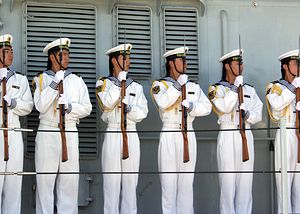China’s pursuit of construction projects to assert its claims to disputed territory in the South China Sea is intensifying. As Victor Robert Lee reported in The Diplomat last week, land reclamation and buildups have expanded from the Spratly Islands, where China is pursuing military installations, including radar towers, gun emplacements, port facilities, and airstrips, to the Paracel Islands, just 400 kilometers off of the Vietnamese coast. According to satellite imagery, Beijing is looking into major expansions of runway and airport facilities there.
Now, per a report from Jeffrey Lin and P.W. Singer in Popular Science released Monday, China will have a new tool to pursue their ambitions further into the oil-rich sea: 1,000,000 ton floating islands, mobile battle stations that can be converted for civilian and military use, allowing for resupplying forces in the region, aircraft landing, hangar storage, and providing a naval base for amphibious vehicles. The largest model of the vessel, proposed by Tangshan-based Jidang Development Group, would measure out at 900 meters in length by 120 meters in width, and around 300 meters by 90 meters for the smallest design. JDG’s models are built from semi-submersible hull components that can be attached to one another, making the battle stations potentially scalable to much greater sizes.
While this all sounds somewhat futuristic, the use of floating islands is not a historically unprecedented idea. The British Royal Navy hoped to construct a 2 million ton “aircraft carrier” during World War II, in hopes of sinking German U-Boats and other Nazi vessels that wracked havoc on trade and maritime supply routes. More recently, the U.S. Navy tried to roll out the Joint Mobile Offshore Base in 2000, a design which included plans for a 1.5 mile airstrip. Elsewhere, a few commercial designs have been able to get off the ground: Shell Australia’s Prelude, weighing in at around 600,000 tons, can extract and liquefy natural gas from underwater wells, and offload those supplies to ships for transport to energy customers all over the world.
But with China showing a remarkable ability to rapidly convert coral reefs into military outposts, the islands could be a particularly useful supplement to its anti-access, area-denial systems (A2/AD). The battle stations could also do more to offset Washington’s tremendous basing advantages in the Asia-Pacific theater.
China could also uses these structures to accommodate civilians and vacationers. The mobile units are big enough to house mobile resorts, apartments, and other lodging. On the logistical side of things, the People’s Liberation Army Navy (PLA(N)) could utilize the massive bases for a range of air-sea capabilities, including docking, energy storage, and air strips, which China could use for rapid response to humanitarian crises in the region.
The islands may not be the linchpin of Beijing’s strategy in the South China Sea. But with the situation heating up in the region, they could certainly be helpful.

































